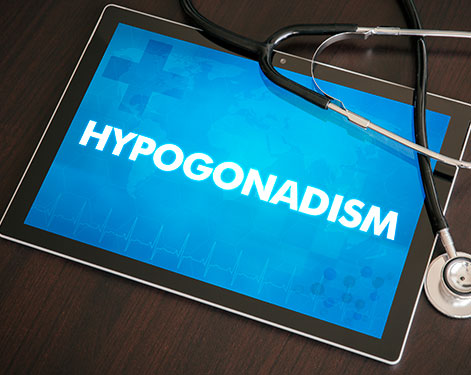Get Started
Complete the short form belowto Contact a Nexel Medical physician

You will know if you need testosterone therapy by learning to recognize the signs and symptoms of low testosterone in men and women.
There are many signs and symptoms of low testosterone, a condition that can also be referred to as “hypogonadism” or having a “testosterone deficiency.”
Testosterone deficiency is when your body is not producing enough testosterone. There can be several causes for a testosterone deficiency, but the most common reason for low testosterone is the steady decline in testosterone that occurs as men and women age.
Low testosterone can be a problem because testosterone is a major hormone that regulates or influences many of the bodily processes that keep you strong and vital.
If you are diagnosed with low testosterone, you may need testosterone therapy. The best way to understand if you are a candidate for testosterone therapy is to learn to recognize the signs and symptoms of low testosterone.
Men and women who are suffering from a testosterone deficiency will likely need testosterone therapy. Testosterone therapy is a doctor-prescribed, clinically proven method to treat men and women with low testosterone.
Although technically a “male” hormone, testosterone is vital to the health and well-being of both men and women. Despite the important role that testosterone plays in strength, energy, vitality, and sexual wellness, testosterone levels dwindle as you age. This can result in age-related testosterone deficiency or low testosterone, a condition sometimes simply referred to as “low T.”
Testosterone replacement therapy has been shown to have many life-changing benefits for men and women suffering from low-T due to age-related testosterone decline.
Men and women who are suffering from a testosterone deficiency will likely need testosterone therapy.
According to The Cleveland Clinic, low testosterone affects almost 40% of men aged 45 and older. It is difficult to define normal testosterone levels because levels vary throughout the day and are affected by body mass index (BMI), nutrition, alcohol consumption, certain medications, age, and illness.
A man’s testosterone level starts to decline after the age of 30 and continues to decrease by about 1 to 2 percent a year for the rest of his life.
It has also been said that about 2 out of every 100 men under 30, or 2% of younger men, have low-T, while some studies suggest that as many as 50% of men 80 or older have testosterone deficiency. So, age is certainly a factor in determining how common low testosterone is in men.
Diabetes, obesity, and other health conditions also play a role, with 30% of obese men of any age also suffering from low testosterone, as opposed to only about 6% of men of comparable ages of normal weight.
Many of the signs and symptoms of low testosterone overlap between men and women. There are also symptoms of low testosterone that are unique to each gender.
Generally, testosterone deficiency impacts three major areas of your life:
Broadly, the signs and symptoms of testosterone deficiency are a decreased sex drive, fatigue, weight gain, loss of muscle and bone mass, and changes in mood.
Some of the most common signs and symptoms of testosterone deficiency and why they occur include:
Testosterone is a precursor to the release of nitric oxide during sexual arousal, which starts several reactions that result in an erection.
Men and women experience hair loss as they age. Often this is the result of age-related testosterone decline.
Testosterone helps to produce bone tissue and maintain bone mass and density.
Patients with low testosterone report difficulties in falling asleep or staying asleep. This could be because low T can lead to obesity, which can lead to sleep apnea.
Both men and women with testosterone deficiency experience a decrease in sex drive.
Testosterone plays a role in the development of muscle mass. Testosterone deficiency often results in significant loss of muscle mass.
We used to think that loss of estrogen was responsible for the hot flashes and night sweats experienced by menopausal women. We now know that hot flashes, and many of the debilitating symptoms of menopause, are more likely caused by testosterone deficiency in women.
Some of the other more common symptoms of testosterone deficiency include:
Some of the less common signs and symptoms of testosterone deficiency in men and women include:
You will know if you need testosterone therapy by learning to recognize the signs and symptoms of low testosterone in men and women.
To receive a diagnosis of testosterone deficiency, you first must have your testosterone levels tested. Low testosterone is diagnosed with a simple blood test that measures the level of testosterone in your blood. There is no special preparation needed for a testosterone blood test.
Testosterone therapy is only available with a doctor’s prescription. You cannot legally purchase testosterone anywhere in the United States without a doctor’s prescription. Therefore, there is only one way to legally start testosterone therapy. It is not complicated. In fact, it only takes Five Simple Steps.
Studies have shown that testosterone replacement therapy provides a wide range of benefits for men and women with testosterone deficiencies. Such benefits include improved libido, mood, cognition, muscle mass, bone density, and red blood cell production. Some of the other benefits of testosterone replacement include:
In addition, testosterone replacement therapy may reduce the risk of diabetes and some cancers, as well as lower your risk of stroke or heart attack.
Your first program of testosterone therapy is usually prescribed for a course of six months. Here is a month-by-month breakdown of what benefits you can expect from testosterone replacement therapy.
During your initial four to six weeks of testosterone therapy, the first you will notice is significant increases in vitality and energy. You should also start to see:
Once you have completed two months of testosterone therapy, your ability to focus and concentrate will be greatly improved. This is the time in your program when you will start to see a definite “before and after” body in your mirror. Fat around your midsection should be significantly reduced, and your muscle tone will increase. Other results you can expect after two months of testosterone replacement therapy include:
As you complete your third month of testosterone therapy, your benefits will continue to accumulate. In month three, you should see:
As you finish your third and enter your fourth month of testosterone therapy, in addition to continued improvements in strength, vitality, and sexual performance, you can expect the following additional before and after benefits of testosterone:
Although you are unlikely to see new benefits in month five, there will continue to be an overall strengthening of everything that has come before. You will barely be able to recognize the person you were before you started testosterone therapy.
Once you are close to completing your first course of testosterone therapy in month 6, you will experience all of the many well-documented benefits of testosterone replacement therapy and an overall improved quality of life.
The complete list of positive results of testosterone therapy are as follows:
Testosterone therapy is an ongoing treatment that continues long-term. After your first six months of treatment, your hormone levels and symptoms will be reevaluated to see if you need to continue treatment. Most patients continue for at least another six months and spend a full year on treatment.
The best treatment for testosterone deficiency in men and women is testosterone replacement therapy.
Now that you know more about how to know if you need testosterone therapy, why not take a minute to contact us and learn more about how hormone replacement therapy can improve your quality of life?
Complete The Short Form Below To Contact a Nexel Medical Physician
